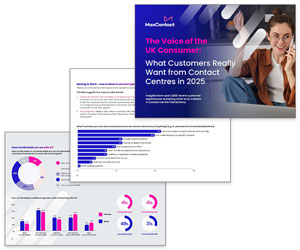Paul Pember details 11 best-practice principles to ensure that your organization has an effective ‘Voice of the Customer’ survey.
As consumers, we often receive customer surveys after purchasing a service or product, but they vary in levels of effectiveness. This article will support you in avoiding these mistakes by outlining what a ‘VoC’ survey is, why it’s important and providing 11 best-practice principles.
The main purpose of a VoC (Voice of the Customer) survey is to gain feedback from customers on how they feel about your organization, product, or service, and their specific experiences when interacting with your organization. Thus is done by asking a set of questions, via text, phone or digitally.
The survey will help organizations identify specific areas that drive customer satisfaction. VoC surveys can be split into two core types:
- Transactional Survey: soon after purchasing a product or service
- Perception-Based Survey: ad hoc survey sent to customers to gain a better understanding of their feelings towards your organization, brand, product, or/and service
Best Practices for a Voice of the Customer Survey
Put simply, it’s the act of listening to your customers and learning about their experiences. To ensure you have an effective voice of the customer survey, below are 11 best-practice tips:
1. When Asking Quantitative Questions, Give Customers Four or Five Rating Options
To ensure customers have enough choice, best practice is giving them four or five options to rate their satisfaction with your organization.
Too few rating options will mask the variations of satisfaction, and too many options will confuse customers and not give organizations any more added value than just having four or five options.
The benefit of just offering four options is that this removes the option for customers to sit on the fence and forces them to choose whether they are satisfied or not.
For example:
| Option | Rating |
|---|---|
| Very Satisfied | 4 |
| Fairly Satisfied | 3 |
| Fairly Dissatisfied | 2 |
| Very Dissatisfied | 1 |
Recommendation: Removing the 5th ‘neutral’ option (neither satisfied nor dissatisfied) ensures that customers cannot sit on the fence. Therefore, the 4-rating score is to be preferred.
2. Ask No More Than Six Questions, But Give Them the Option to Answer More
Asking between four and six questions is commonly known as best practice. However, this can vary depending on whether it’s a transactional or perception-based survey.
Perception-based surveys are generally conducted less regularly and need more depth, therefore asking more than six questions is common.
Customers don’t always have the time, care, or energy to answer lots of questions about their experience with your organization. Many customers who have a bad experience won’t ever tell you.
Therefore, it’s critical to make it simple, easy, and quick for customers to be able to share their feedback with you, to enable you to learn and improve.
To ensure you capture as many customer opinions as possible, you could have a core set of initial questions and then ask them if they are happy to continue to further questions.
This could go on another a few times. This gives customers the power to choose how many questions they answer depending on their preference, and it enables you to reach a wide range of engaged customers.
To create customer service surveys that deliver actionable insights to improve contact centre performance, read our article: How to Create the Best Customer Service Survey – With Examples
3. Don’t Be Afraid to Mix Your Questions Up
It’s easy for customer surveys to be a routine business activity that stays static over months and years. However, it’s good practice to mix up your questions and have specific campaigns to deep-dive on a specific area.
Best-practice VoC surveys have optional, rotation and themed questions linked to strategic priorities. Don’t ask questions for the sake of it. What do your customers value? Design questions that gain feedback on this.
For example, if low effort is a key thing for the customer, make sure you have a question that is dedicated to customer effort and gain verbatim reasons on why it was high effort and how it could be more effortless.
However, it’s recommended that you ask a consistent core set of questions focused on satisfaction or effort or have qualitative questions asking for verbatim feedback, as this will enable you to track and monitor trends over time.
4. Align the Ordering of Your Survey Questions With Their Customer Journey
When designing your survey, ensure the questions are in a logical order, aligned to the customer journey. This will help customers remember their experience and steps with your organization.
It will then provide you with a more accurate reflection of their experience and enhance the quality of insights you receive from the survey.
In addition, it ensures you ask about all the key steps in their journey, which enables you to identify the specific points in the journey that need attention.
Read our article How to Use Customer Feedback to Improve Journey Maps to discover how you can use customer feedback to enhance their experience with your brand
5. Ask Both Quantitative and Qualitative Questions
- Quantitative = numbers and ratings, good for tracking trends and monitoring overall satisfaction
- Qualitative = words, good for understanding specific experiences in the customers’ words
The old saying of 1+1=3, accurately describes the power of asking both quantitative and qualitative questions within your survey.
It will provide your organization with a treasure chest of insights that gives you trends, themes, and feedback suggestions that can power your understanding of what matters most to customers, and most importantly, it can give you ideas on how to improve the customer experience.
Just asking quantitative questions would be a missed opportunity to gain an understanding of what customers think about the experience in their own words.
6. Develop a Service Recovery Process Within Your Customer Survey Strategy
This is all about ensuring your organization is prepared and ready for customers who have had a bad experience with your organization and aren’t satisfied.
To achieve this, ensure your organization designs a workflow and process that enables real-time flags when a customer has rated you poorly.
Timeliness is key; therefore, the workflow needs to be minutes/hours, not days. This will enable your organization to ‘recover’ the situation, by contacting the customer to understand what their issue is and how you can rectify it.
Successful service recovery can turn a frustrated and dissatisfied customer into a loyal one that shouts about your organization and becomes an advocate.
7. Make the Survey Human, Don’t Make It Sound Like It’s Been Written by a Robot
Be human. Make it feel like you’re right next to them asking the questions. Many organizations fall into the trap of making the surveys a little robotic and clinical.
Surveys are another opportunity to reinforce your organization’s identity and personality.
To illustrate this, your survey could be written like it’s from your CEO – showcasing the importance of customer feedback and making it feel like a person is asking the questions, rather than a computer.
This makes it more human and engaging.
8. Ensure the Survey Questions Can Be Understood Easily
It’s easy for us to fall into the trap of using internal business terms or technical language and for them to infiltrate our normal language.
However, it’s vital that your survey questions don’t have business lingo or technical terms (where possible) that customers will struggle to understand.
Ensuring your survey questions are simple and easy to understand will reduce survey drop-out, as customers will find it effortless to complete, often when they are on the go.
Survey Drop-Out = when customers start to complete your survey and quit before completing it
9. Don’t Ask More Than One Question in a Question
This relates to a recurring theme in many of these principles, making it easy for customers to understand and complete your survey.
Make sure you only ask one question at a time, and don’t try and ask multiple questions within the same question.
This can confuse customers, increase the likelihood of survey drop-out and decrease the quality of insight.
Good Question:
How was your experience with X company?
Bad Question:
How was your experience with X company? Would you recommend us to friends and family?
10. Act on the Insight From Your Voice of the Customer Survey
Having an effective voice of the customer survey is just one part of the story. The next part is ensuring your organization learns and acts on the insight.
This will require building a structure, method and culture that enables the organization to turn survey data into insight, and insight into action.
The benefits of this will improve trust with customers and reduce the risk of apathy, as they will understand that their time and feedback is actually being used to develop your organization.
Therefore, communicate what you do with the feedback and how your organization is using it to constantly learn and improve.
11. Develop Workflows and Processes to Ensure You Don’t Over-Survey Customers
The world is full of customer surveys, and it can be a little annoying for customers if they are receiving too many.
Therefore, it’s critical your organization doesn’t over-survey customers and that they can choose to opt out.
To ensure you’re not surveying the same customers every time, develop controls and processes through your Customer Relationship Management (CRM) system to prevent this from happening.

Being strategic with when and how you ask customers for their feedback will enhance the quality of insight and reduce harm to the relationship.
Written by: Paul Pember, Customer Service Specialist
For more great ideas and suggestions for your VoC programme, read these articles next
- 20 Smart Ideas to Improve Your Voice of the Customer Programme
- How to Provide Closed-Loop Feedback With Employees and Customers
- Drive the Voice of the Customer Into the Business for Real Change
- 5 Places to Source Great Customer Feedback
Author: Paul Pember
Reviewed by: Robyn Coppell
Published On: 21st Sep 2022 - Last modified: 21st Oct 2025
Read more about - Customer Service Strategy, Customer Feedback, Paul Pember, Service Strategy, Voice of the Customer






































